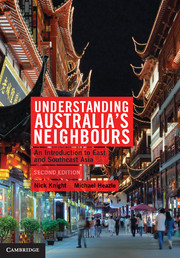Book contents
- Frontmatter
- Contents
- List of Maps
- Acronyms and abbreviations
- Acknowledgments
- Maps
- Introduction
- 1 The idea of ‘Asia’
- 2 Tradition and modernity in East and Southeast Asia
- 3 Tradition and modernity in East and Southeast Asia
- 4 Colonialism in East and Southeast Asia
- 5 Nationalism and revolution in East and Southeast Asia
- 6 Nations and nation-building in East and Southeast Asia
- 7 International politics and East and Southeast Asia
- 8 Economic growth in East and Southeast Asia
- 9 Democracy, human rights and development
- 10 Globalisation and East and Southeast Asia
- 11 China–Japan relations and US power in the twenty-first century
- 12 Australia in Asia, ‘Asia’ in Australia
- Bibliography
- Index
- References
5 - Nationalism and revolution in East and Southeast Asia
Published online by Cambridge University Press: 05 June 2012
- Frontmatter
- Contents
- List of Maps
- Acronyms and abbreviations
- Acknowledgments
- Maps
- Introduction
- 1 The idea of ‘Asia’
- 2 Tradition and modernity in East and Southeast Asia
- 3 Tradition and modernity in East and Southeast Asia
- 4 Colonialism in East and Southeast Asia
- 5 Nationalism and revolution in East and Southeast Asia
- 6 Nations and nation-building in East and Southeast Asia
- 7 International politics and East and Southeast Asia
- 8 Economic growth in East and Southeast Asia
- 9 Democracy, human rights and development
- 10 Globalisation and East and Southeast Asia
- 11 China–Japan relations and US power in the twenty-first century
- 12 Australia in Asia, ‘Asia’ in Australia
- Bibliography
- Index
- References
Summary
IN THE PREVIOUS CHAPTER we examined the ‘age of colonialism’ and noted that historians are divided about the impact of the West on the histories of East and Southeast Asian societies. Some historians have argued that it is incorrect to interpret the history of the region from 1498 to the mid-1950s as nothing more than the history of European colonialism, with the history of East and Southeast Asia limited to a response to this external influence. This view, they argue, ignores the internal historical forces and social structures that existed in the region prior to European intervention and which persisted largely untouched throughout the ‘age of colonialism’. Other historians have pointed to the dramatic and long-term consequences of European colonialism in the region, and argue that it is appropriate both to talk of an ‘age of colonialism’ and to read the history of East and Southeast Asia from this perspective.
Although some historians speak of the ‘age of colonialism’ as though it is an historical period whose dominant characteristic is European colonialism, control of East and Southeast Asia by European colonial powers was in fact sporadic and quite limited during most of this period. European colonial power did not peak until the latter half of the nineteenth century and, even then, some societies in the region managed to avoid direct colonisation. Siam (Thailand) is an example, although it only managed to retain a semblance of independence by deferring to the economic and political demands of Britain and France, the two neighbouring colonial powers in Burma and Indochina. Another example is Japan, which avoided direct Western intervention after 1853 only by acceding to demands that Japan open its doors to commerce and trade. Indeed, the significant influence of the West on Thailand and Japan, two countries that were not colonised, suggests that the cumulative influence of Europe in East and Southeast Asia was very great, particularly in those countries that were colonised. By the end of the nineteenth century, most of Southeast Asia had been colonised, and China, the largest country in the region by population and area, had become a semi-colony, divided into spheres of European influence.
- Type
- Chapter
- Information
- Understanding Australia's NeighboursAn Introduction to East and Southeast Asia, pp. 81 - 101Publisher: Cambridge University PressPrint publication year: 2011



